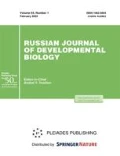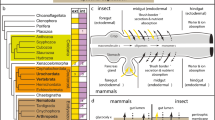Abstract
The analysis of comparative-embryological and molecular-biological data leads to the conclusion that universal basic mechanisms of morphogenesis occurred first in the evolution of animals in the ancestors of modern sponges and eumetazoans, which served as a basis of different evolution of individual development in Parazoa and Eumetazoa lines. In the former, morphogenesis in early embryogenesis led to formation of the water-current system as a means for capturing and delivery of food particles to different parts of the animal. In the latter, morphogenetic movements manifested themselves as gastrulation, during which the germ layers and the digestive system formed. The morphogenetic movements of cells in Metazoa emerged independently of cell specification. They are primary relative to cell differentiation. The unity of all Metazoa is based on the similarity of mechanisms of morphogenesis rather than on the presence of germ layers.
Similar content being viewed by others
References
Adamska, M., Degnan, S.M., Green, K.M., Adamski, M., Larroux, C., and Degnan, B.M., Wnt and TGF-β expression in the sponge Amphimedon queenslandica and the origin of metazoan embryonic patterning, PLoS One, 2007, vol. 2, no. 10, p. e1031. doi: 10.1371/journal. pone.0001031
Adamska, M., Larroux, C., Adamski, M., Green, K., Lovas, E., Koop, D., Richards, G.S., Zwafink, C., and Degnan, B.M., Structure and expression of conserved Wnt pathway components in the demosponge Amphimedon queenslandica, Evol. Devel., 2010, vol. 12, no. 5, pp. 494–518.
Adamska, M., Degnan, B.M., Green, K., and Zwafink, C., What sponges can tell us about the evolution of developmental processes, Zoology, 2011, vol. 114, pp. 1–10.
Adell, T. and Müller, W.E., Isolation and characterization of five Fox (Forkhead) genes from the sponge Suberites domuncula, Gene, 2004, vol. 334, pp. 35–46.
Allman, G., On the anatomy and physiology of Cordylophora, a contribution to our knowledge of the tubularian zoophytes, Phil. Transact. Roy. Soc., 1853, vol. 143, pp. 367–384.
Beklemishev, V.N., Osnovy sravnitel’noi anatomii bespozvonochnykh (Fundamentals of Comparative Anatomy of Invertebrates), 1964.
Delage, Y., Sur la place des Spongiaires dans la classification, C. R. Acad. Paris, 1898, vol. 126, pp. 545–548.
Ereskovskii, A.V., Sravnitel’naya embriologiya gubok (Porifera) (Comparative Embryology of Sponges (Porifera)), St. Petersburg: Izd. St.-Peterb. Gos Univ., 2005.
Ereskovsky, A.V. and Dondua, A.K., The problem of germ layers in sponges (Porifera) and some issues concerning early metazoan evolution, Zool. Anz., 2006, vol. 245, pp. 65–76.
Galliot, B., Quiquand, M., Ghila, L., de Rosa, R., Miljkovic-Licina, M., and Chera, S., Origins of neurogenesis, a cnidarian view, Dev. Biol., 2009, vol. 332, pp. 2–24.
Gazave, E., Lapebie, P., Renard, E., Bezac, C., Boury-Esnault, N., Vacelet, J., Perez, T., Manuel, M., and Borchiellini, C., NK homeobox genes with choanocytespecific expression in homoscleromorph sponges, Dev. Genes Evol., 2008, vol. 218, pp. 479–489.
Guder, C., Philipp, I., Lengfeld, T., Watanabe, H., Hobmayer, B., and Holstein, T.W., The Wnt code: cnidarians signal the way, Oncogene, 2006, vol. 25, pp. 7450–7460.
Harcet, M., Roller, M., Cetkovic, H., Perina, D., Wiens, M., Müller, W.E., and Vlahovicek, K., Demosponge EST sequencing reveals a complex genetic toolkit of the simplest metazoans, Mol. Biol. Evol., 2010, vol. 27, pp. 2747–2756.
Henkart, P., Humphreys, S., and Humphreys, T., Characterization of sponge aggregation factor. a unique proteoglycan complex, Biochemistry, 1973, vol. 12, pp. 3045–3050.
Ivanov, P.P., Obshchaya i sravnitel’naya embriologiya (General and Comparative Embryology), Moscow, 1937.
Ivanova-Kazas, O.M., Sravnitel’naya embriologiya bespozvonochnykh zhivotnykh (Comparative Embryology of Invertebrates), Novosibirsk: Nauka, 1975.
Kumburegama, S., Wijesena, N., Xu, R., and Wikramanayake, A.H., Strabismus-mediated primary archenteron invagination is uncoupled from Wnt/β-catenin-dependent endoderm cell fate specification in Nematostella vectensis (Anthozoa, Cnidaria): implications for the evolution of gastrulation, Evodevo, 2011, vol. 21, p. 2.
Kusserow, A., Pang, K., Sturm, C., Hrouda, M., Lentfer, J., et al., Unexpected complexity of the Wnt gene family in a sea anemone, Nature, 2005, vol. 433, pp. 156–160.
Lapébie, P., Gazave, E., Ereskovsky, A., Derelle, R., Bézac, C., et al., WNT/β-Catenin signalling and epithelial patterning in the homoscleromorph sponge Oscarella, PLoS One, 2009, vol. 4, no. 6, p. e5823. doi: 10.1371
Larroux, C., Fahey, B., Degnan, S.M., Adamski, M., Rokhsar, D.S., and Degnan, B.M., The NK homeobox gene cluster predates the origin of Hox genes, Curr. Biol., 2007, vol. 17, pp. 706–710.
Larroux, C., Luke, G.N., Koopman, P., Rokhsar, D.S., Shimeld, S.M., and Degnan, B.M., Genesis and expansion of metazoan transcription factor gene classes, Mol. Biol. Evol., 2008, vol. 25, pp. 980–996.
Manuel, M., Le Parco, Y., and Borchiellini, C., Comparative analysis of brachyury T-domains, with the characterization of two new sponge sequences, from a hexactinellid and a calcisponge, Gene, 2004, vol. 340, pp. 291–301.
Mazza, M.E., Pang, K., Martindale, M.Q., and Finnerty, J.R., Genomic organization, gene structure, and developmental expression of three clustered otx genes in the sea anemone Nematostella vectensis, J. Exp. Zool. (Mol. Dev. Evol.), 2007, vol. 308B, pp. 494–506.
Müller, W.E.G., Cell membranes in sponges, Int. Rev. Cytol., 1982, vol. 77, pp. 129–181.
Müller, W.E.G. and Müller, I.M., Porifera: an enigmatic taxon disclosed by molecular biology/cell biology, in Porifera Research: Biodiversity, Innovation and Sustainability, Custodio, M.R., et al., Eds., 2007, pp. 89–106.
Müller, W.E.G. and Zahn, R.K., Purification and characterization of a species-specific aggregation factor in sponges, Exp. Cell Res., 1973, vol. 80, pp. 95–104.
Müller, W.E.G., Blumbach, B., Wagner-Hülsmann, C., and Lessel, U., Galectins in the phylogenetically oldest Metazoa, the Sponges (Porifera), Trends Glycosci. Glycotechnol., 1997, vol. 9, pp. 123–130.
Nichols, S.A., Dirks, W., Pearse, J.S., and King, N., Early evolution of animal cell signaling and adhesion genes, Proc. Natl. Acad. Sci. USA, 2006, vol. 103, pp. 12451–12456.
Oliveri, P., Walton, K.D., Davidson, E.H., and McClay, D.R., Repression of mesodermal fate by foxa, a key endoderm regulator of the sea urchin embryo, Development, 2006, vol. 133, pp. 4173–4181.
Pancer, Z., Kruse, M., Müller, I., and Müller, W.E.G., On the origin of adhesion receptors of Metazoa: cloning of the integrin α subunit cDNA from the sponge Geodia cydonium, Mol. Biol. Evol., 1997, vol. 14, pp. 391–398.
Pfeifer, K., Haasemann, M., Gamulin, V., Bretting, H., Fahrenholz, F., and Müller, W.E.G., S-Type lectins occur also in invertebrates: high conservation of the carbohydrate recognition domain in the lectin genes from the marine sponge Geodia cydonium, Glycobiology, 1993, vol. 3, pp. 179–184.
Ryan, J.F. and Baxevanis, A.D., Hox, Wnt, and the evolution of the primary body axis: insights from the early-divergent phyla, Biol. Direct., 2007, vol. 2, p. 37.
Seravin, L.N. and Gudkov, A.V., Trichoplax adhaerens (tip Placozoa) odno iz samykh primitivnykh mnogokletochnykh zhivotnykh (Trichoplax adhaerens (Type Placozoa) Is One of the Most Primitive Multicellular Animals), St. Petersburg, 2005.
Srivastava, M., Simakov, O., Chapman, J., Fahey, B., Gauthier, M.E.A., et al., The Amphimedon queenslandica genome and the evolution of animal complexity, Nature, 2010, vol. 466, pp. 720–727.
Svetlov, P.G., On the significance of the theory of germ layers in modern science, Arkh. Anat. Gist. Embr., 1963, vol. 44, no. 4, pp. 7–25.
Vacelet, J. and Duport, E., Prey capture and digestion in the carnivorous sponge Asbestopluma hypogea (Porifera: Demospongiae), Zoomorphology, 2004, vol. 123, pp. 179–190.
Vogt, C., Embryologie des salmons, in Histoire naturelle des poissons d’eau douce de l’Europe centrale par L. Agassiz, 2° Livraison, 1842.
Wimmer, W., Blumbach, B., Diehl-Seifert, B., Koziol, C., Batel, R., Steffen, R., Müller, I.M., and Müller, W.G., Increased expression of integrin and receptor tyrosine kinase genes during autograft fusion in the sponge Geodia cydonium, Cell Adhes. Commun., 1999, vol. 7, pp. 111–124.
Windsor, P.J. and Leys, S.P., Wnt signaling and induction in the sponge Aquiferous system: evidence for an ancient origin of the organizer, Evol. Dev., 2010, vol. 12, pp. 481–590.
Author information
Authors and Affiliations
Corresponding author
Additional information
Original Russian Text © A.K. Dondua, R.P. Kostyuchenko, 2013, published in Ontogenez, 2013, Vol. 44, No. 5, pp. 357–363.
Rights and permissions
About this article
Cite this article
Dondua, A.K., Kostyuchenko, R.P. Concerning one obsolete tradition: Does gastrulation in sponges exist?. Russ J Dev Biol 44, 267–272 (2013). https://doi.org/10.1134/S1062360413050020
Received:
Accepted:
Published:
Issue Date:
DOI: https://doi.org/10.1134/S1062360413050020




